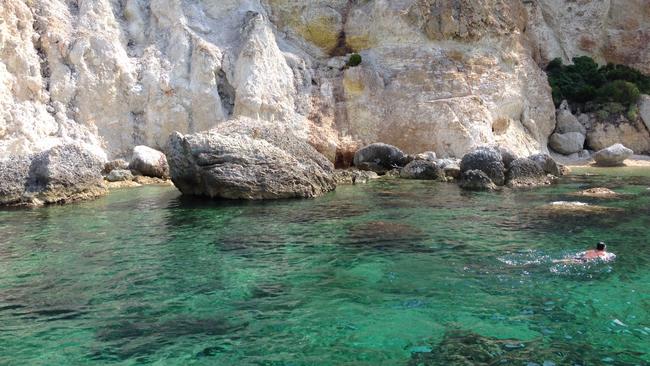The stunning Italian islands where wicked Roman emperors sent lustful women
THESE islands look picture perfect, but they hide a dark past. They’re where wild women committed incest and were sent by their emperor husbands to their gruesome deaths.

ROMAN countesses, actresses and designers like the Fendi sisters have picked the Pontine islands, a cluster of paradise-atolls near Rome, as their élite summer retreat.
But it wasn’t so in the past. It was a female inferno. Forget the glossy boutiques, wild night-life and elegant lounge bars packed with tanned beauties of all ages in search of romance. Women in ancient times were confined here to suffer. They fell into depression and a few were even sentenced to death. A bunch of lustful, or simply “disobedient” Roman empresses, were exiled to these isles during Rome’s glorious days by their cruel husband-emperors. As I put on some screen block and embark on a three day cruise of the archipelago, I’m shocked by how the surrounding beauty contrasts with its dark history. True, women were not the only ones to be jailed here, but they faced the harshest destiny. Revolutionaries, anarchists, anti-royalists, bandits and criminals of all kinds were shipped to these rocks up until the 1960s. Mussolini’s exiled his political enemies, while Europe’s founding fathers came up with the European Union project behind such “bars”. Dubbed the ‘Pearls of the Tyrrhenian Sea’, these volcanic isles are among the Mediterranean’s most stunning: Mars-like red and yellow cliffs, purple-blue caves, Jurassic-looking beaches and diving heavens with tropical-clear waters brimming with groupers and barracudas. Picturesque fishermen villages are a maze of yellow, purple, red, green and blue dwellings. Prehistoric grottos mingle with the ancient Roman harbours and colonial villas of pioneers sent by the Bourbon Kings in the 1700s. You can swim in fisheries, cisterns and salines where the Romans used to skinny-dip. My first stop is Ventotene, a 2km sq flat piece of land shaped like a lizard named Pandataria by the ancient Romans. The manager of the local Parata Grande resort, Antonio Santomauro tells me with a cheeky smile, “Today it’s ladies’ paradise, they come to flirt and party. Back then if your husband wanted to get rid of you, he’d ship you here and it was your end. Times have changed, unfortunately. I got to pay my ex wife a monthly check”. As he gives me the grand tour of Giulia’s Villa, I can’t help to feel pity for the women who were imprisoned in what are now ruins. It suddenly hits me that some ancestors of mine, down the line, had an awful stay. The villa today is an open-air archaeological wonder with incredibly well-kept floor mosaics and royal chambers full of amphoras. It sits atop Punta Eolo cliff, named after the Wind God, with a breathtaking view that stretches all the way to Mount Vesuvius. As the sea breeze picks-up and the sun sets the sky bleeds but despite the scenery, I feel goose bumps running down my spine. “Fate was cruel on these women. And ironic: they were all related to one another, part of the same Roman lineage. Mother, daughter, granddaughter”, Antonio points out. The first inmate was Giulia, confined in the first century BC by her own pitiless father, Emperor Augustus. Giulia was smart and lascivious: she was a married woman but kept a wide number of lovers and spent her nights in brothels, drinking and getting wild. Her third husband Tiberius, successor to the throne, could not tolerate her behaviour and forced her father to exile her. On the isle Giulia was followed everywhere by imperial guards, never had a man nor could she indulge in the pleasure of wearing a silk gown and perfume. After five years she was transferred to another prison. Thirty years later Giulia’s daughter lands on the same piece of land: Agrippina Major. Her husband had been poisoned and she had lost her mind. She wanted vengeance. Emperor Tiberius got fed up with her whining and so thought it wise to ship her to Ventotene, without even the urn containing her beloved husband’s ashes. Agrippina was fragile: she became history’s first victim of anorexia. After three years of exile she died of hunger. But the worst had yet to come. “See that space, that’s the thermal bath where another Roman nobleman was later killed”, says Antonio pointing to a hole in the ground. I’m so intrigued by the horror tale I can almost spot blood stains. “In order to marry cruel Poppaea, Emperor Nero, the grandson of Agrippina Major, had sentenced to death his poor wife Octavia on charges of adultery. She had a supposed affair with a gladiator. One night imperial assassins tied her to the tub and cut her wrists. She died in a steamy bloodbath. Octavia’s head was brought back to Rome on a platter.” That’s it. My stomach churns in disgust. I need a Martini to forget the horror and remind myself I’m on holiday. But I just can’t party, haunted by the ghosts of those poor ladies who were simply victims of imperial plotting. The next day I move on to Ponza Island, where I learn that Giulia’s granddaughter, Agrippina Minor, daughter of Agrippina Major, was confined here together with her sister Livilla but both were luckier than their granny and mum. Despite having had an incestuous relationship with their brother Emperor Caligula, they had conspired against him and were punished for this. Agrippina, however, was tough and proud. She mistreated her guards, acted like a queen and gave orders to everyone. She never skipped a meal and kept fit taking long strolls on Chiaia di Luna beach while plotting her revenge. When her brother died she returned to Rome and became the most powerful women by marrying Emperor Claudius. Hey, we’re talking of Nero’s mother! It’s the lady who then poisoned her husband to place her crazy son on the throne. Agrippina Minor somehow makes me feel better and I can finally relax. I take a dinghy to the two uninhabited atolls of Palmarola and Zannone: mesmerising collapsed natural arches, cathedral-shaped stags and untouched pebble beaches. Back in Ponza I dine with Silverio Capone, a local historian, who tells me that another Roman noblewoman was exiled and killed here. Her name was Flavia Domitilla, she was the granddaughter of a powerful consul but was far from being lewd: in fact, she was so virtuous she ended up being one of the first Christian martyrs. For dessert Silverio gives me a treat. “Homer sung of the seductive power of supernatural women who inhabited these sacred atolls. Did you know that Ponza is where Odysseus, on his way back home from burning Troy, was bewitched by Sorceress Circe who made him her sex slave? And that Ventotene is where the Greek hero had to plug his ears against the Sirens’ songs?” Fishermen legends still talk of weird fish that often end up in nets and drowning sailors being rescued by beautiful women. Well, that does the trick. Myth has the power to redeem history.



